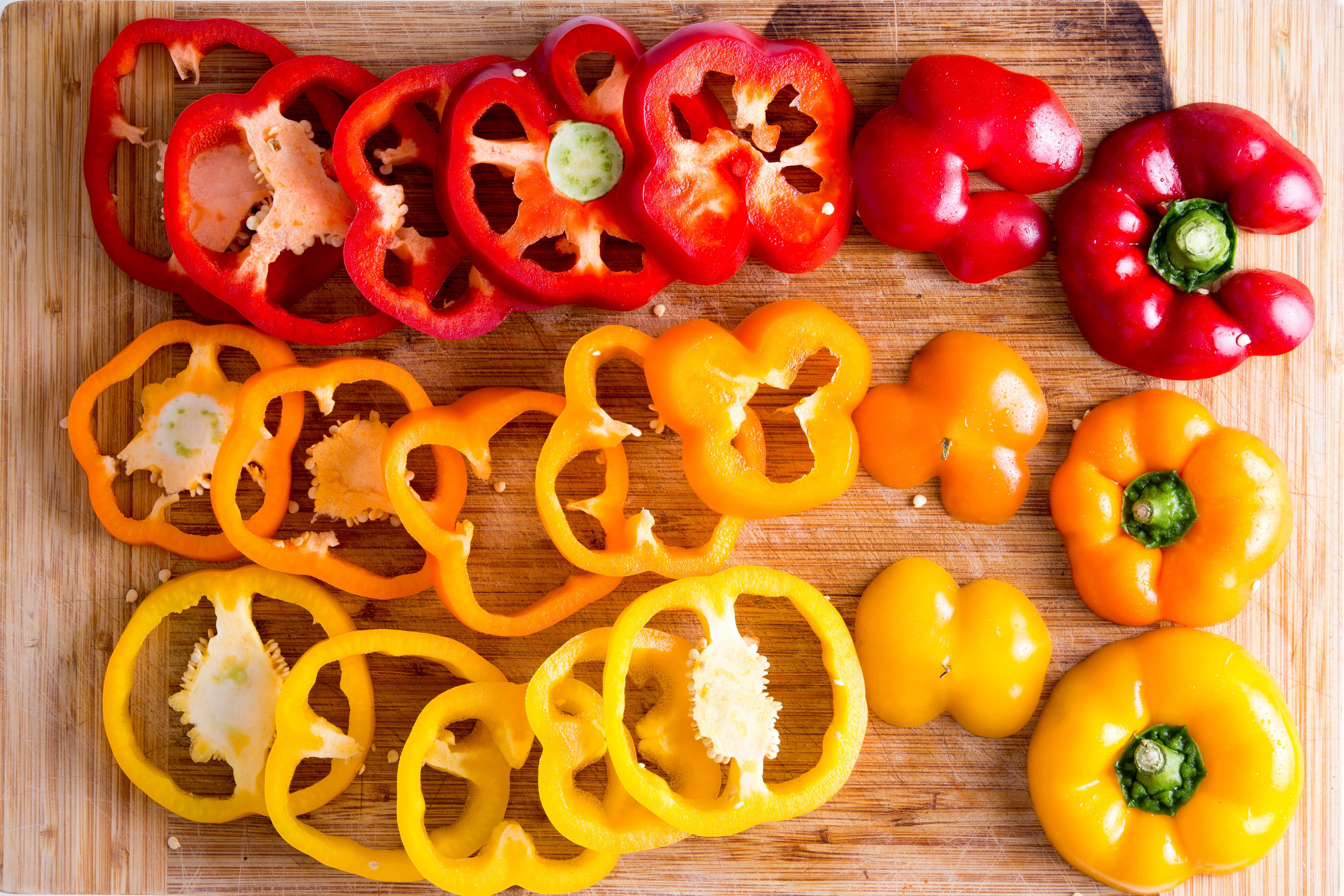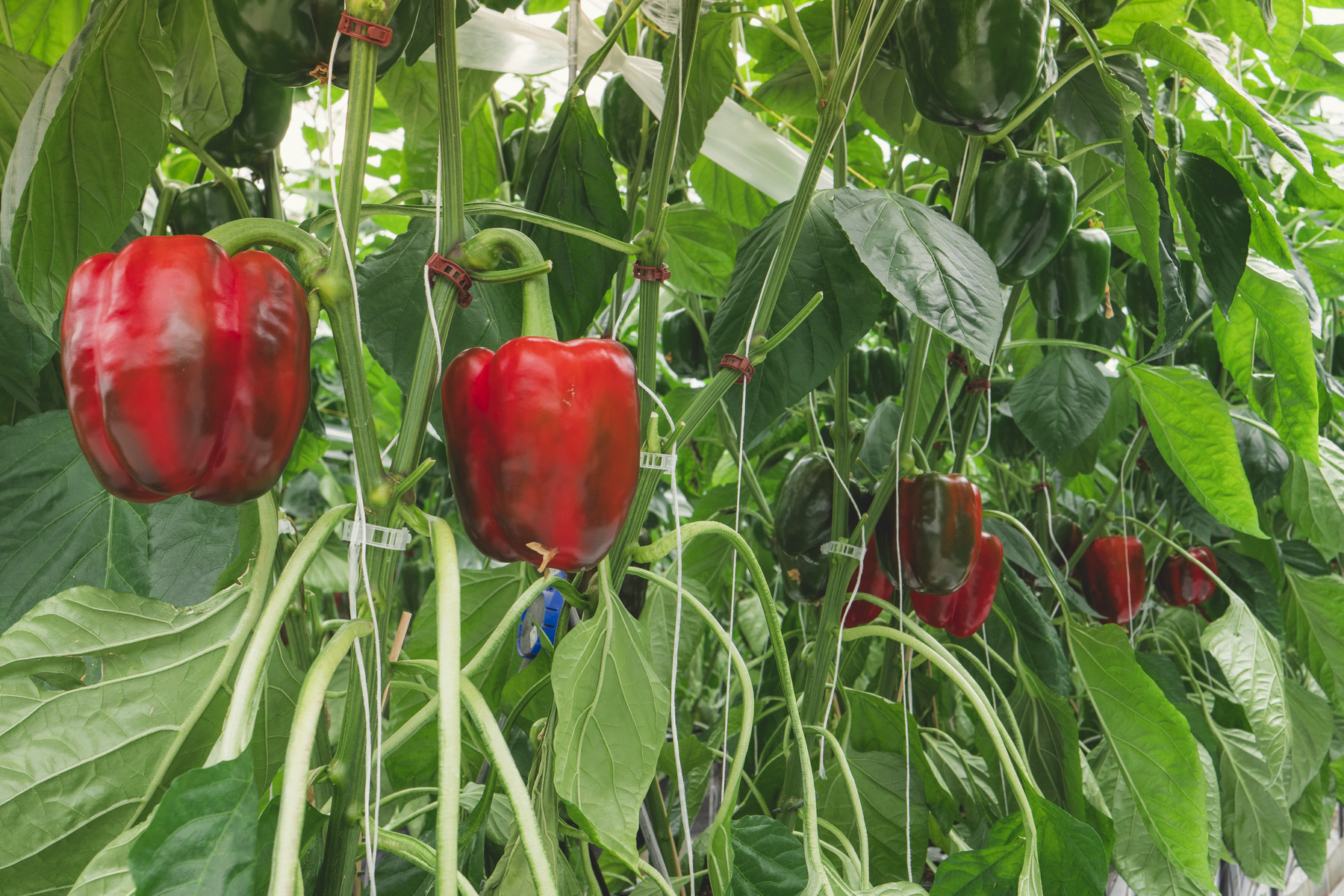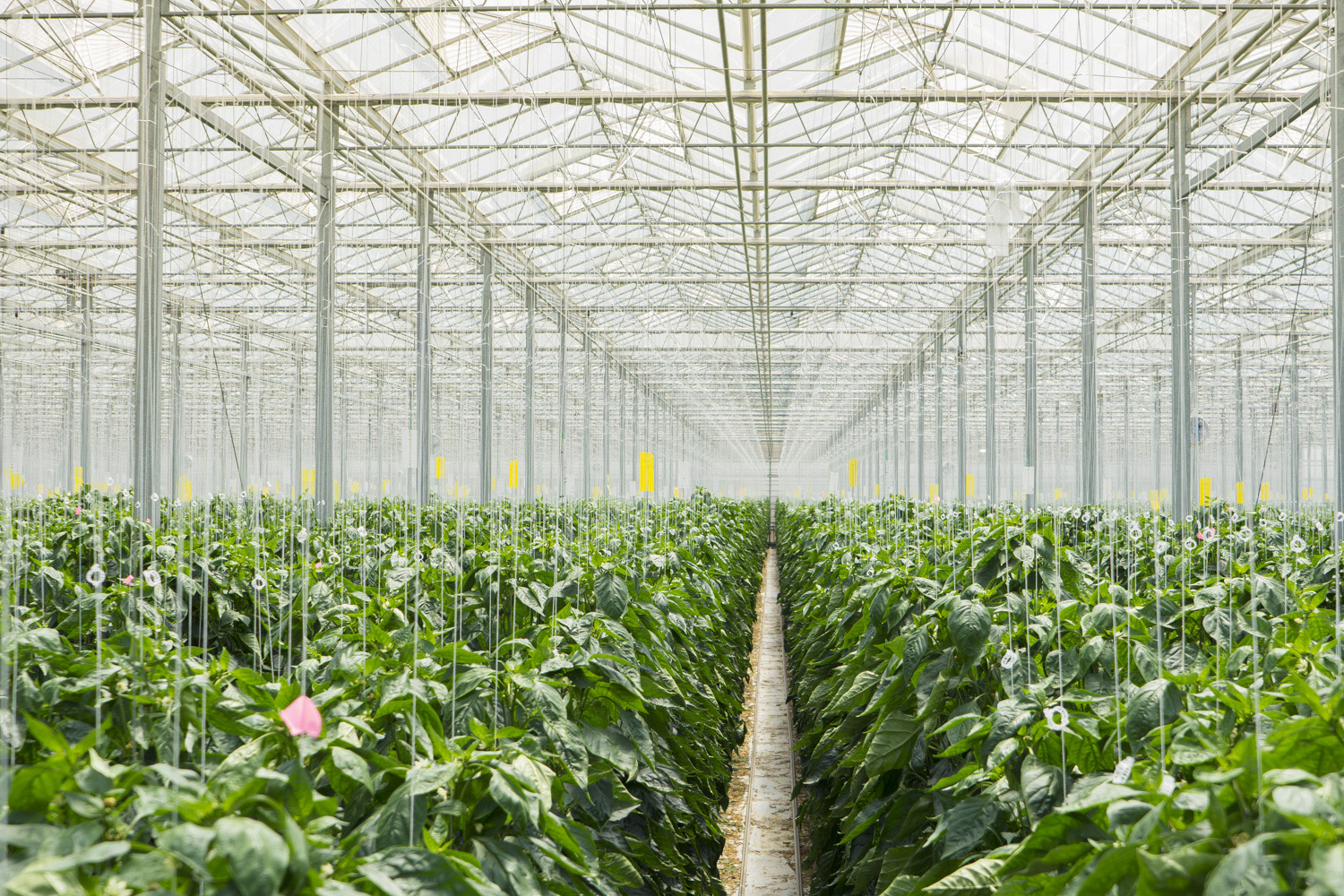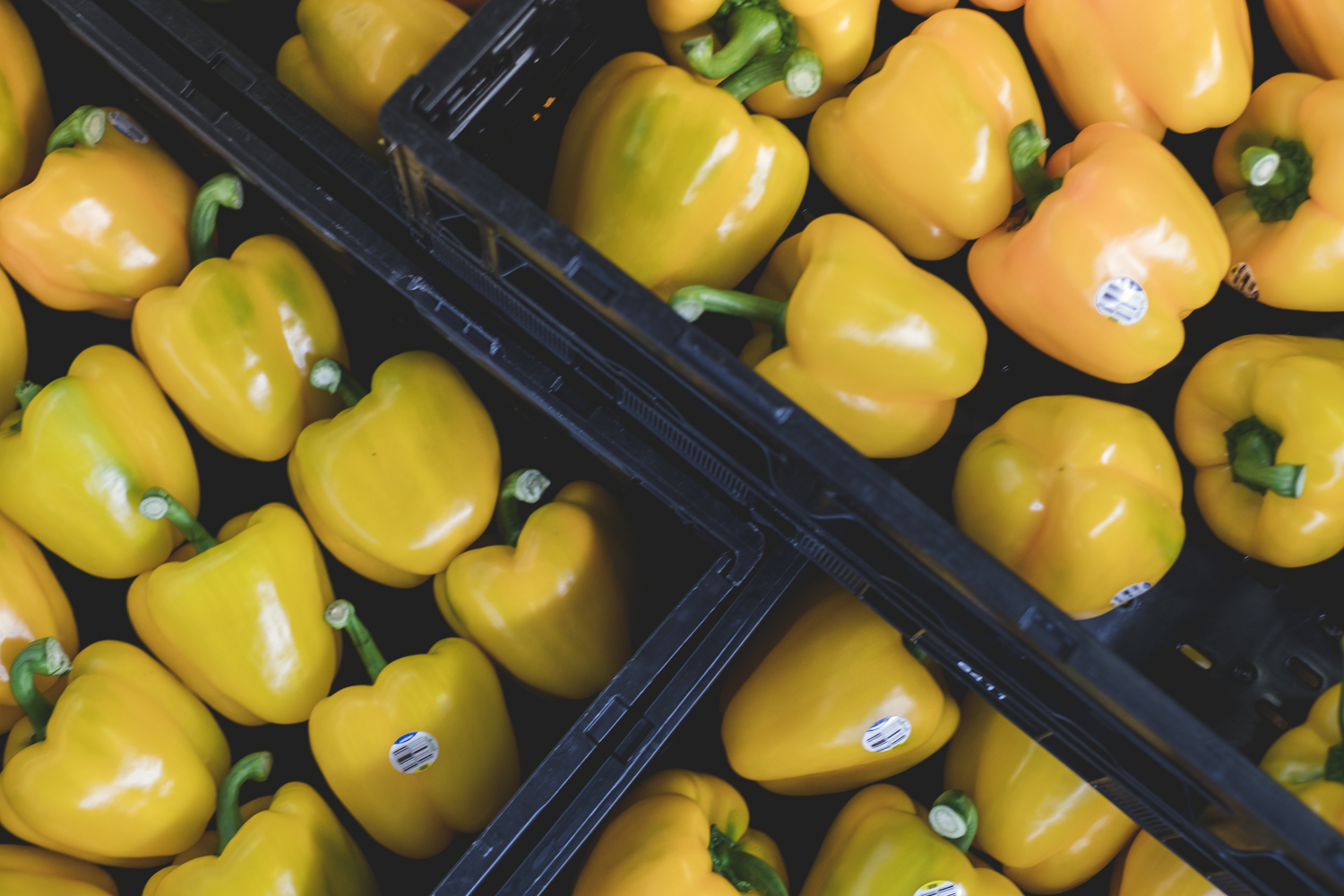Every day, people ask us dozens of questions about the food that we grow in our greenhouses. This month, we decided to answer your most hard-pressing questions about Bell Peppers. Our experts delivered with top-notch answers to questions about Bell Pepper health benefits, color, storage, and growth!
Most Frequently Asked Questions About Bell Peppers
What are the health benefits of eating Bell Peppers?
Red, Orange, and Yellow Bell Peppers are full of great health benefits—they’re packed with vitamins and low in calories! They are an excellent source of vitamin A, vitamin C, and potassium. Bell Peppers also contain a healthy dose of fiber, folate, and iron.
Along with being full of nutrients, Bell Peppers deliver a satisfying and low-calorie crunch with every bite. Try eating snappy Bell Peppers instead of high-calorie chips and crackers with dips like hummus or salsa!

Why are Bell Peppers different colors?
Even in nature, Bell Peppers change from Green to their destined color as they ripen. This is because, just like with Tomatoes or Cucumbers, there are many different varieties of Bell Peppers. Some varieties turn from Green to Red, others turn from Green to Orange, and still others change from Green to Yellow. The most popular colors are Red, Orange, and Yellow, but there are even Purple Bell Peppers out there!
At NatureFresh™, we use over five different varieties of Bell Pepper seeds to produce Red, Orange, and Yellow Bell Peppers. The most popular color of Bell Pepper that we grow is Red; however, the Orange Bell Pepper varieties that we grow are widely considered to be our sweetest!
Are Green Bell Peppers really just unripe Red Bell Peppers?
Some of them, yes. But some of them could be unripe Orange or Yellow Bell Peppers! A Green Bell Pepper is a prematurely picked Bell Pepper of any variety. This means that there is no such thing as a Green Bell Pepper variety!
By being prematurely picked, Green Bell Peppers do not receive all the natural sugars that a Pepper would normally get from the ripening process. This is why Green Bell Peppers have a more bitter taste compared to Red, Orange, or Yellow Bell Peppers – they are picked before they can start to get sweet!

Which color of Bell Pepper is the healthiest?
Red, Orange, and Yellow Bell Peppers have very similar health benefits to one another. Even though they are different colors, they all have similar amounts of vitamin A and vitamin C in them. Red Bell Peppers also contain lycopene, an antioxidant or carotenoid that helps fight free radicals in your body. Learn more about lycopene and its amazing health benefits here. Yellow and Orange Bell Peppers are also rich in carotenoids.
One thing to note is that all three colors of Bell Peppers that we grow have substantially more nutritional value than Green Bell Peppers – this is because Green Bell Peppers are picked before the ripening process is complete and all the nutrients and natural sugars enter the Pepper.
How long does it take for Bell Pepper plants to grow?
Just like Tomatoes and Cucumbers, growing Bell Peppers in a greenhouse is very different than growing them in a garden.
From planting to harvest, it takes about 12 weeks for our first batch of Bell Peppers to grow in the greenhouse. This is a longer period of time than you would see in a garden setting, but the difference is that while a Bell Pepper plant in a garden will only bear a handful of Peppers, a Bell Pepper plant in a greenhouse will produce roughly forty Bell Peppers in one season!
With a longer growing season and perfect climate, greenhouse-grown Bell Pepper plants will yield substantially more Bell Peppers than garden-grown plants.

How do you know when Bell Peppers are ready to pick?
You know that a Bell Pepper is ready to pick when it has ripened to full color. This means that there is minimal to no green color left on the skin of the Bell Pepper.
By letting a Bell Pepper ripen fully, you are also getting all the nutritional benefits from it! That is exactly why we pick all our Bell Peppers (and Tomatoes and Cucumbers, for that matter) when they are fully vine-ripened – we want to make sure that you and your family are getting all the health benefits you possibly can from the food you eat!
What should I look for when choosing a Bell Pepper?
When choosing a Bell Pepper, you want to find one without any sunburn spots, shriveling, or signs of decay (basically, if a Pepper looks like it is on its ‘last leg’, you may want to pass on it). A common misconception is that scarring is a bad defect, but scarring does not affect the quality, flavor, or freshness of Peppers!
Many people think that Bell Peppers with two or three lobes aren’t as good – this is also false! If the Bell Pepper doesn’t have the above-mentioned defects, a two or three lobe Pepper is just as healthy and nutritious a choice as a four lobe Pepper.
It’s important to think about what you’re using your Bell Peppers for when choosing them at the grocery store. If you are cutting them up for a salad, you don’t need a pristine-looking Pepper. However, if you’re using them to cook Stuffed Peppers, a four lobe Pepper is your best bet.

Do Bell Peppers need to be refrigerated?
Yes – as soon as you bring your Bell Peppers home, make sure you put them in one of your fridge’s crisper drawers. Your raw Bell Peppers will last between one and two weeks in your fridge – just make sure you store them dry!
Cut Bell Peppers will not last as long – about two to three days. Make sure you only cut your Bell Peppers as you need them to keep them at their freshest (and to decrease the potential for food waste in your kitchen)!
For more storage tips about Bell Peppers and the other produce that we grow (including Tomatoes and Cucumbers), see our Veggie Storage Guide!
What are some of the best ways to enjoy or prepare Bell Peppers?
Bell Peppers are extremely versatile – you can enjoy them grilled, sautéed, in soups or sauces, and even raw! Don’t limit yourself to eating Green or Red Bell Peppers, which are the most commonly eaten colors. Orange and Yellow Bell Peppers are just as sweet and provide a fun splash of color to any meal or snack!
Everyone knows that Stuffed Bell Peppers are a delicious meal option, but don’t limit yourself to just stuffing them – Bell Peppers can be a fun addition to so many other great recipes. Try something different like our Bell Pepper Lentil Dip or Red Bell Pepper Coulis Crepes. Get creative and take advantage of the versatility of this superfood!
Make sure you check out these 12 Unique Ways to Prepare Peppers for more great inspiration!

Are Bell Peppers vegetables or fruits?
Along with Tomatoes and Cucumbers, Bell Peppers are one of those foods that are always contentious – are they a fruit or a veggie? Although they are commonly considered a vegetable, Bell Peppers are technically fruits because they contain seeds!
When people think of fruits, they almost always think of apples, oranges, pears, or peaches – this is because a common misconception is that fruits only grow on trees. But a fruit is any produce item that has seeds! So, since Bell Peppers have seeds, they are technically fruits.
Find more produce facts by reading our frequently asked questions about Tomatoes and Cucumbers.



